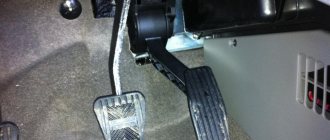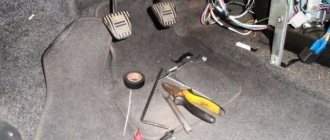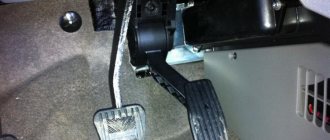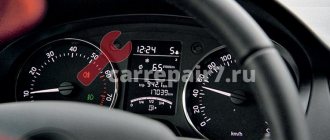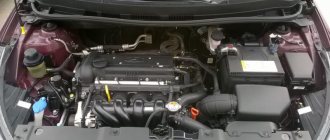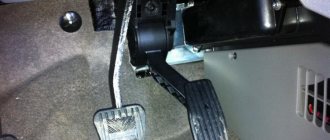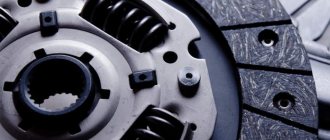The appearance of electronic gas pedals on a car at one time created a sensation: now the formation of the fuel-air mixture almost entirely falls on the electronic control system! The electronic gas pedal on the Priora car has become something new: low price, simplicity of design and progress have done their job. If everyone is accustomed to a mechanical throttle valve drive (with a cable), the new “version” of the accelerator pedal immediately found its fans. This design was called “E-gas”. The Priora was not installed on the car right away - only in January 2011. The price of the gas pedal is from 1000 to 1500 rubles. The design of the E-gas Priora is not so simple as to simply replace the mechanism for opening/closing the throttle valve; for the most part, repairs or replacements are operations in which “communication” with the electronic control unit is indispensable. In case of malfunctions: the E-gas part has shortcomings, it becomes dull, the speed fluctuates - read the article and find out in detail about this!
Electronic gas pedal on the Lada Priora - looks like this
Electronic gas pedal: how it works
This is a plastic lever that is mounted on a bracket. The bracket contains two sensors that continuously read the position of the accelerator lever (the degree of pressure on the driver’s side). This design is called a gas pedal module. On the other hand, the throttle body was redesigned: it was supplemented by an electric motor, a gearbox, and two independent sensors that regulate the position of the damper.
One of them is the mass air flow sensor (MAF). It determines the volume of air entering each batch of air-fuel mixture. Another sensor (fuel consumption) regulates the position of the throttle valve, thereby “measuring” the volume of gasoline entering the mixture. This sensor first receives data from the ECU about what position the throttle valve should be moved to, and then “records” the throttle position, sending this information to the ECU. The damper is opened by a gear motor, the operation of which is controlled by the ECU. It is prohibited by the manufacturer to manually adjust the position of these dampers; it will not be possible to deliberately enrich the mixture.
On the other hand, the ECU receives data from two more sensors - those located in the accelerator lever module. The pedal sensor reads its position, sends data to the ECU, causing the car to “react” when the gas is pressed. In comparison with the design of old cars with a carburetor, where it was possible to enrich the fuel-air mixture using the throttle control lever (“choke”). In normal mode, the opening of the damper was a consequence of the operation of the mechanical system: when the driver accelerates, the cable connected to it is tensioned, and the damper opens. Today, the driver only has control over the position of the gas pedal.
Causes of the phenomenon
Drop in speed and failure of the gas pedal
There are few reasons for the phenomenon of “failure” when pressing the gas pedal. It often appears after unsuccessful engine chip tuning and is accompanied by an increase in fuel consumption, but there are other problems directly with injection. So, let’s look at the main reasons for the “failure” effect:
- Injectors . The fuel distribution system directly affects engine performance.
Identifying and eliminating ECU errors
Condition of the candles. On the left the mixture is too rich, on the right it is too lean.
These are all the main reasons that can lead to gas pedal failure.
Dips during acceleration
Once the causes are considered, we can consider how to deal with the problem. So, let’s describe step by step what needs to be done when the gas pedal has dips during acceleration:
- The first step is to check the spark plugs. The appearance of carbon deposits or spark plugs that are too clean indicate that the mixture is not adjusted correctly. It is worth adjusting the correct amount of fuel mixture.
- Ignition wires can also cause the vehicle to malfunction.
- A clogged throttle can lead to failures during acceleration.
- The condition of the air filter affects the formation of the mixture, so it is worth changing it on time.
Air filter clogged
Dirty fuel filter
Dirty fuel filter
- ECU errors can also lead to accelerator failures.
- The last reason is clogged injectors. They need to carry out diagnostics, check functionality, and also clean and replace faulty elements.
Thus, the causes of failures during overclocking have been identified and can be eliminated.
Priora - why the speed fluctuates
If the speed on a Priora with E-gas fluctuates, or the warm-up speed disappears, this means that the sensors are not working correctly, “the contact is coming off”. The sensor does not constantly send signals to the electronic control unit, and therefore the ECU acts proactively - it sends commands to the gearbox to close/open the damper. Any diagnostics will show a malfunction of one of the sensors, and first it’s worth looking at its contacts to see if they have become acidic, if the wires are coming off, etc. And if the situation with them is irreparable, you will have to change the sensor.
The car pulls to the side
It is clear that not only the brakes can be to blame for a car drifting off course - the wheel alignment angles, the wheels themselves, and the steering can also be to blame. However, quite often questions arise specifically about the brakes, especially if the car pulls sideways when braking. Most often, jammed pistons in the cylinders of one of the circuits are to blame. It is possible that the wheel may brake due to the loosening of the bolts securing the pad guide to the steering knuckle, as well as the pads getting oily or getting brake fluid on them.
Perhaps an ice or salt crust has formed on the surface of the pads, or the pads are simply wet. Or one of the circuits of the brake system does not work - the pedal is low and the braking efficiency is low. Brake disc runout, wheel bearing wear, and brake drum out-of-roundness may also be to blame.
Malfunctions of the electronic gas pedal
The main faults are as follows:
- When shifting gears (from 1 to 3, most often when shifting to a lower gear), the engine speed increases briefly;
- When driving in first gear, without accelerating, the speed “floats”;
- The car does not “respond” to pressing the gas;
- “Check” is displayed on the dashboard.
If any of these signs appear, use the diagnostic connector on the hundredth - it is located under the glove compartment (glove box). Error codes along with explanations will indicate a specific breakdown. In most cases, the cause of this is mechanical damage to the wiring or sensors:
- Lack of sensor (after the repair, the mechanic forgot to connect or install it);
- Short circuit or open circuit;
- Sticking, oxidation, burning of sensor contacts, due to which signals to and from the ECU are supplied inconsistently.
This problem can be solved by simply replacing the sensors - they do not last forever, they have a short resource. But if two sensors in the pedal unit fail at once, the electronic control unit switches the engine to emergency mode, and then the car will operate at engine speeds no higher than 1500 per minute.
Replacing the idle speed sensor on Kalina
The operation of installing or removing the product is not particularly difficult and is accessible to any car owner, regardless of the level of training, under almost any conditions. Replacement is carried out in the following sequence: 1. First step. During any work related to the vehicle's electrical system, the on-board system is de-energized (to do this, simply disconnect the battery terminal). 2. Second step. We find the regulator and disconnect the contact block with the supply wires from its body. 3. Third step. Using a long Phillips screwdriver, unscrew the mounting screws (2 pieces) and remove the product from the car’s throttle body. 4. We install the new product, the procedure is similar to the removal process only in reverse order. The new sensor does not require adjustment or configuration.
Measures to extend the service life of IACs
It should be noted that it is not always necessary to immediately replace the idle air regulator for an 8-valve Kalina with a new device. Quite often, its proper operation is prevented by banal contamination with oils and tar deposits contained in crankcase gases. Therefore, to restore the performance of the IAC and extend its service life, it is necessary to periodically clean the cone needle and the spring of the product from contamination. In addition, the installation hole itself in the throttle assembly must be cleaned. If you follow the above recommendations, the device will not fail at the most crucial moment and will last for a long time.
In the morning at -1, the revs on the tachometer are first 500, and after 1-2-3 seconds the warm-up speed is 1100. I changed the wires, changed the idle, changed the TPS, changed the spark plugs, changed the coil, called with a multimeter. I checked the DMRV readings 0.98. I installed a new air filter. I changed the idle sensor, removed the throttle, it was clean.
And still the relay makes one click and from 500 it is set to 1100, as it warms up everything is fine, then it is set to 900 and it starts without any hang-ups. I don’t know where to dig, what to look for?
The firmware has not changed, original Bosch. I don’t really know what the numbers are, just if you can write something. I’m already thinking, maybe there’s something wrong with the firmware during a cold start? So the main thing is that it warms up for 1 minute, I turn it off, start it again, this is no longer the case. It’s just some kind of trouble, and if the frost hits -30, it will completely shut down, well, in general, such things.
- At XX, the engine runs intermittently in the Lada Kalina - 7 answers
- VAZ Kalina stalls 2-4 seconds after starting – 6 answers
- It revs itself in the morning at idle, Kalina – 6 answers
- The idle speed on the VAZ Kalina jumped up - 6 answers
- VAZ Kalina stalls when cold or in the cold - 5 answers
If the engine is already running and produces 500 rpm. Then for some reason the relay clicks, right? There the IAC can only click, then yes, the speed will change if it is faulty. Do you have an IAC or a throttle assembly without it? As for changes in the weather and the dependence of engine operation - this could be due to a faulty mass air flow sensor or just because of the “wrong” air filter.
Which relay clicks? Which relay makes the click?
There in the engine only the IAC can click when starting. And these Russian regulators are of disgusting quality (I bought a new remote control, it was clogged and the heating did not work, and on the new IAC it jammed, replaced it, installed the old IAC and the motor worked fine).
You can read about the same story (about the wrong IAC) here.
You don’t have to bother with the firmware, you have a normal controller. And you can’t fix this question with firmware.
Source
Advantages and disadvantages of an electronic pedal
Over the 7 years of operation of the Lada Priora with an electronic throttle control system, car enthusiasts have compiled pronounced pros and cons of operating a car with e-gas.
Advantages:
- Reduced fuel consumption. If you press the gas too hard, the ECU will correct this moment and prevent either overspeeding or increased fuel consumption. “Over-gassing” will not work;
- Environmental friendliness. The introduction of this system took place under the influence of the popular movement of automakers who bring their cars to European standards. Priora is Euro 4 compliant;
- Instant response of the car to pressing the accelerator lever (only if the system is working properly).
Flaws:
- Slow acceleration (dynamic acceleration is lost);
- Non-repairability of the system (sensors can be replaced, but the entire system cannot be repaired);
- Softer pressure.
Sachs clutch
The production of clutches for various car brands also has its own innovations. The clutch, like all other mechanisms, wears out quickly, and every driver wonders how to choose the right mechanism. Driving style and operating conditions are directly proportional to service life. Therefore, Sachs specialists, taking into account all the wishes of drivers, have released completely new, environmentally tested flywheels, release bearings, clutch discs and slave cylinders, compact clutch units and other equally interesting design solutions. These new products include:
- MZ type clutch basket with pull-out action.
- XTend with automatic wear compensation.
- Dual-mass flywheel ZMS.
- Release bearing type CSC.
- Ultra-compact clutch unit (for sports cars).
Which clutch to install is up to you, but if the driver takes good care of his car, replacement can be done after 100,000 km. The clutch pedal is a kind of indicator of the technical condition of the engine and transmission.
It signals various malfunctions and requires prevention and constant monitoring. Competent and correct replacement of the clutch, using all the capabilities of these designs will extend the life of your car.
E-gas adjustment
The electronic throttle is adjusted according to only one parameter – the response time of the gas pedal. It is adjusted by simply moving the accelerator pedal unit (APB). It is factory sealed and this work is usually carried out at an authorized service center, but the operation is simple and can be done with your own hands. Not on all Prioras, adjustment is possible, but on cars produced since 2014, adjustment is definitely possible.
To adjust E-gas you need:
- Open the hood, remove the wipers, frill, negative terminal from the battery, the battery itself, get close to the pedal block.
- In the pedal block, unscrew the three nuts of the accelerator block. Do not disconnect the harness! Otherwise, the setting will still become factory default.
- Loosen (do not pull out!) two screws on top and one on the bottom and move the block horizontally. To the right (relative to the driver) – short response, to the left (relative to the driver) – long response.
Product delivery options
Note! Below are the shipping methods available specifically for this product. Payment options may vary depending on the shipping method. Detailed information can be found on the “Delivery and Payment” page.
Parcel by Russian Post
- Cash on delivery (payment upon receipt)
- Using cards Sberbank, VTB, Post Bank, Tinkoff
- Yandex money
- QIWI
- ROBOKASSA
Parcel by Russian Post 1st class
- Cash on delivery (payment upon receipt)
- Using cards Sberbank, VTB, Post Bank, Tinkoff
- Yandex money
- QIWI
- ROBOKASSA
Express Parcel EMS
- Cash on delivery (payment upon receipt)
- Using cards Sberbank, VTB, Post Bank, Tinkoff
- Yandex money
- QIWI
- ROBOKASSA
Transport companies
- Using cards Sberbank, VTB, Post Bank, Tinkoff
- Yandex money
- QIWI
- ROBOKASSA
Courier delivery in Togliatti
Delivery time from 1 to 12 hours. Pickup from our warehouse
Pickup times must coincide with store opening hours. |
conclusions
The main cause of failures are spark plugs, but they are not the only ones that influence the appearance of this effect. Some car enthusiasts may not be able to cope with the occurrence of such malfunctions on their own, and it is necessary to go to a car service center, where they will carry out high-quality diagnostics and also fix the problem. But it is worth considering that you will have to be generous, since neither computer diagnostics nor repairs will cost a penny.
The brakes, of course, were invented by cowards - any reckless driver will tell you that. But when you realize that there is “something wrong” with them, it becomes scary to get behind the wheel: the trip may be your last. We drive thoughts like “it will do” away: the jokes are over
It is important to determine the type of malfunction - at least in advance
